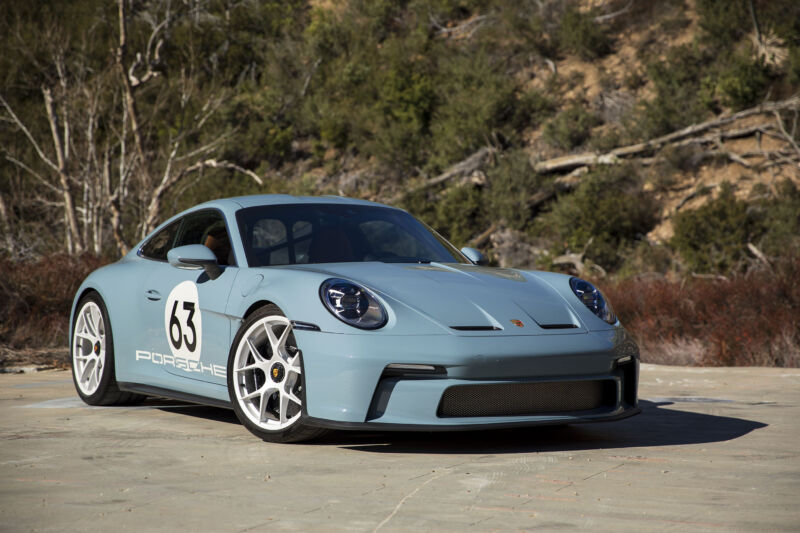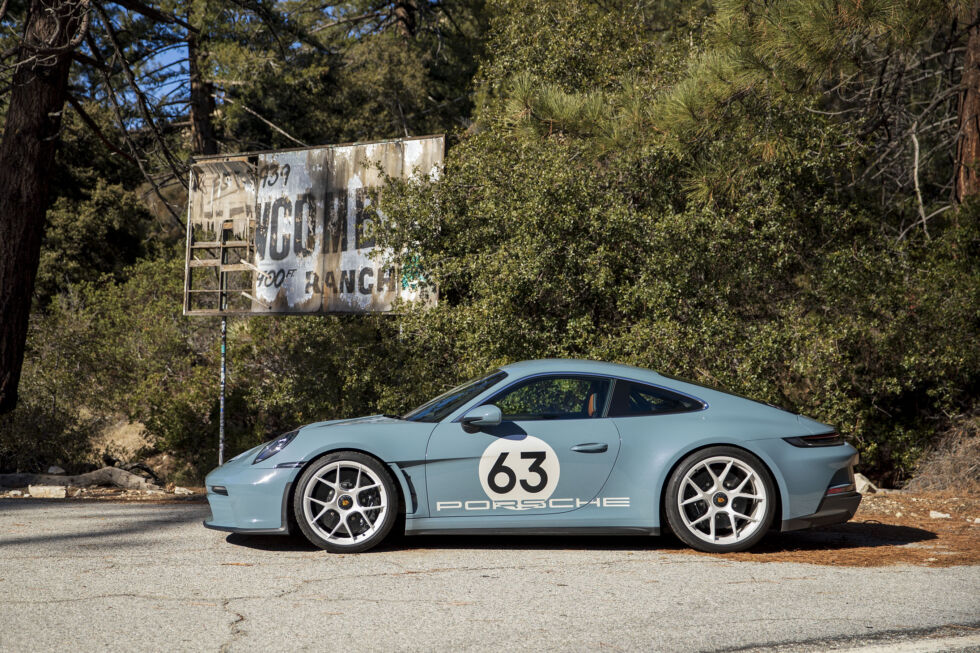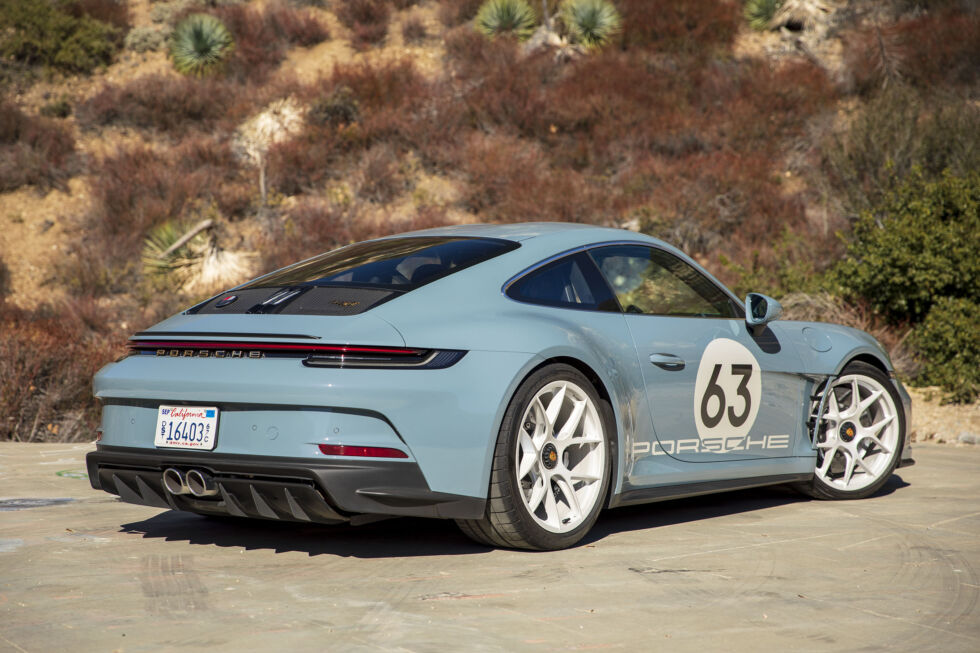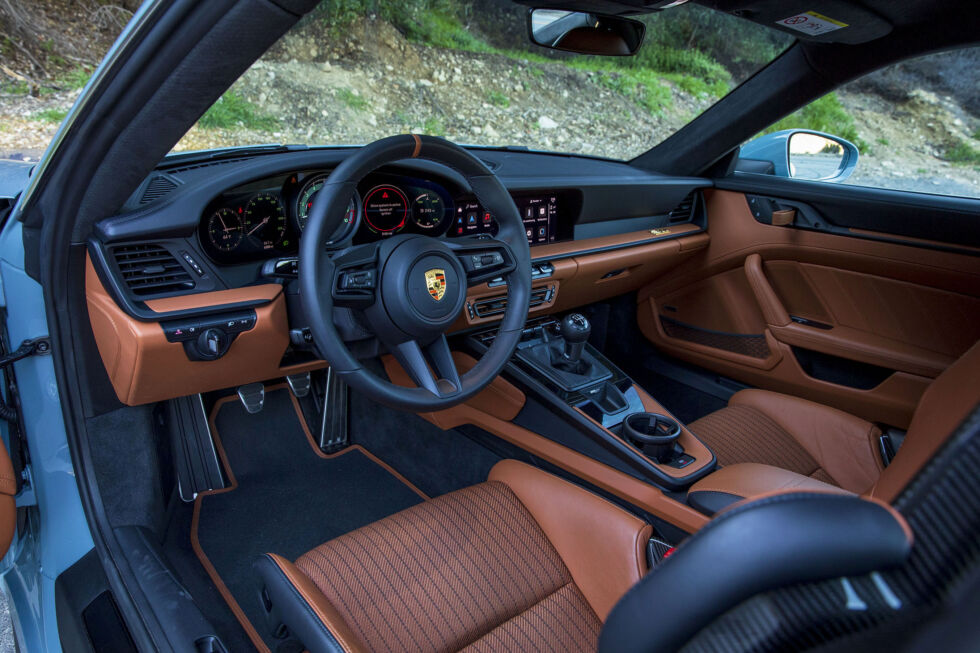The S/T celebrates the 60th anniversary of the 911 and is limited to just 1963 examples.

Although Porsche is in the midst of taking its BEV technology mainstream, the company hasn’t lost sight of the fact that its high-performance reputation was built on the 911.
Over the past few years, the automaker has developed a myriad of different versions of the iconic sports car, resulting in offerings that currently range from plush open-top cruisers to hardcore track monsters, along with special edition models like the off-road-tuned Dakar and heritage-inspired Sport Classic. You might be wondering, then, if there’s really an opportunity for a new performance-focused model to stand out in the 911 lineup.
On the surface, the S/T seems to tread much of the same ground already occupied by the GT3 Touring, an iteration of the track-ready GT3 that ditches the large fixed rear wing for the smaller, aesthetically subtler active rear spoiler found on Carrera models. But as lovely to drive as the GT3 Touring is, it feels like a conceptual afterthought.
Because of its reduced downforce, Porsche has always considered the Touring to be a GT3 intended for the street rather than the track, yet the model’s tuning has otherwise remained unchanged from the standard GT3. This, along with a number of other crucial updates, allows the S/T to stand out from the crowd not just among fast 911s but among sports cars in general.

The name is a nod to a racing version of the 911 S from the late 1960s: Internally known as the ST, the package included modifications to the chassis, engine, and body to improve performance. But unlike the iconic Carrera RS 2.7 that would debut a few years down the road, the ST lacked the aggressive aerodynamic elements that would later come to define the look of track-tuned 911s.Advertisement
The core hardware involved is an interesting amalgamation of components from the current GT division lineup. In a purposely old-school approach not unlike the Sport Classic, the S/T pairs the GT3 RS’s naturally aspirated 518 hp (386 kW) 4.0-liter flat-six engine with the GT3’s six-speed manual gearbox—a combination that can’t be had in any other factory-produced 911.
Like the GT3 RS, the S/T’s hood, front fenders, doors, and roof are made from carbon fiber, and thanks to its magnesium wheels, fixed-back carbon bucket seats, and other weight-reducing components that are equipped as standard, it manages to tip the scales at a svelte 3,056 lbs (1,390 kg), making this the lightest 911 of the current generation.

Adding power and cutting weight are certainly welcome developments for performance enthusiasts, but it’s the raft of subtle, less quantifiable changes that make the S/T such an incredibly compelling sports car. Porsche’s goal was to create the ultimate canyon carver rather than an apex-hunting track machine, and as such, it has tossed the GT3’s rear axle steering system and retuned the suspension dampers for the less-than-perfect tarmac that’s typical of twisty backroads.
To further ratchet up driver engagement, engineers reduced the height of the shift lever by 10 mm, resulting in even shorter, more precise throws. The transmission’s gear ratios were shortened by 8 percent to allow the engine to climb to its searing 9,000 rpm redline more rapidly, resulting in more frequent shifting. There’s a new lightweight clutch and single mass flywheel on board, too.
The latter plays a surprisingly big role in the S/T’s distinctive character, allowing the engine to sweep through the revs with a level of manic urgency that makes the GT3 Touring seem almost lazy by comparison. And thanks to the S/T’s reduced sound deadening compared to the GT3 (which already has significantly less sound deadening than a 911 Carrera), every mechanical process that normally takes place behind the scenes is brought to the forefront. It can equate to noisy steady-state driving at times, but the soundtrack that the S/T delivers when you’re rowing through the gears easily makes up for it.

Although the bodywork is largely shared with the GT3 Touring, there are some visual callouts that distinguish the S/T from its stablemate, like the side-vented fenders, the double-bubble roof, and the small Gurney flap that adorns the active rear wing. This particular example also boasts the S/T’s optional Heritage Design package, which includes exclusive Shore Blue Metallic paint, motorsport decals, the Ceramica wheel color, historic Porsche crests on the hood and wheels, gold Porsche lettering on the rump, Cognac semi-aniline leather interior, and a few other unique touches.
The cabin isn’t a huge departure from the GT3, but there are some differences that become immediately evident once you’re behind the wheel. The green color scheme of the gauges and clock, for example, pays homage to early 911s. And in keeping with the theme of road-focused simplicity, Porsche has ditched the steering wheel-mounted drive mode selector, opting instead to pare down the number of vehicle adjustment settings to those that can, for the most part, be accessed on the bank of buttons just below the infotainment display.
There’s a refreshing, back-to-basics clarity about the S/T that feels purposeful rather than austere. Out on the fast, winding roads of the Angeles National Forest, there are sections where the suspension dampers’ stiffer Sport setting does a slightly better job of managing mid-corner bumps and high-speed undulations, but the S/T is perfectly happy to dispatch your favorite stretch of road with aplomb regardless of whether you’ve selected the perfect combination of settings for the situation—a burden that is far too common with today’s high-performance vehicles. Rather than trying to fix the dish with additional spices and garnish, the S/T serves as an example of a sports car recipe that just has the right ingredients to begin with.Advertisement
- The eagle-eyed among you will note there’s no rotary drive mode selector poking off the bottom wheel spoke. Bradley Iger
- Porsche still uses a physical tachometer on either side of a pair of digital displays, but for how much longer? All its more recent cars use a 12.-6-inch curved display instead. Bradley Iger
- Leather door pulls reference early lightweight 911s. Bradley Iger

Thanks to its low curb weight, purposeful tuning, and generous pilfering of the GT3 RS toy box, the S/T is stunningly capable yet totally approachable. Pirelli P Zero Corsa tires are standard for the car, and while they don’t have quite the same level of immediacy as the Michelin Pilot Sport Cup 2 R that’s available on the GT3 and GT3 RS, the car doesn’t feel held back by the change, as they offer a deep well of mechanical grip and very consistent behavior both in the corners and under heavy braking.
While I have no doubt that the S/T is a riot on a road course, the goal here was to deliver a thrilling drive on the road, and it absolutely delivers in that regard. Noisy cabin aside, the S/T’s approach also results in a GT3-like 911 that’s noticeably easier to live with out in the real world.
These tweaks don’t come cheap, though. At $291,650, the S/T demands more than $100,000 over the base price of a GT3 Touring, a figure that makes this the most expensive 911 on sale today. Whether or not the S/T is worth the premium is ultimately a subjective endeavor, and regardless of where you might stand on that issue, there’s little doubt that they’ll be transacting for quite a bit more than that on the second-hand market after the mandatory one-year lease period has run its course.
Porsche says it added this flipper-deterring clause to the S/T’s sales contract to ensure that the cars get into the hands of real enthusiasts. Here’s hoping it works—if there was ever a car that deserved to be celebrated for the driving experience that it provides rather than its potential market value, it’s this one.




